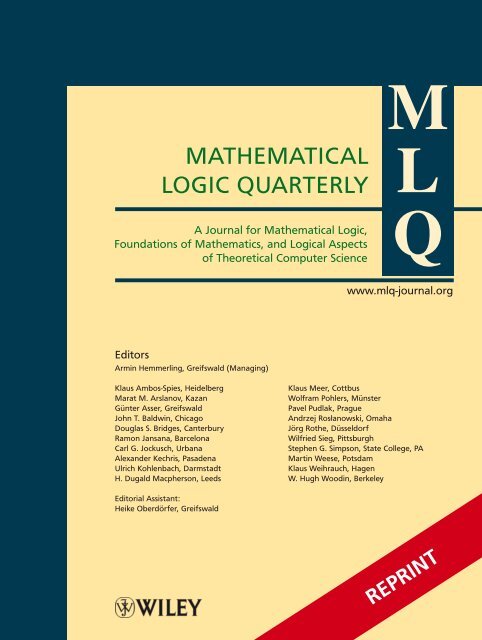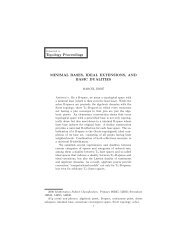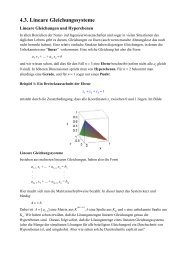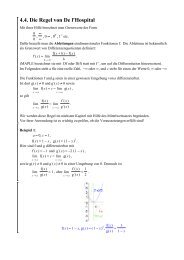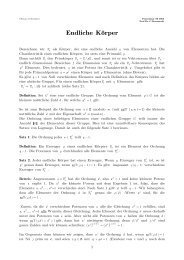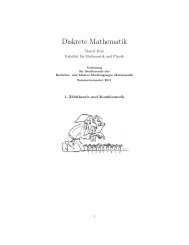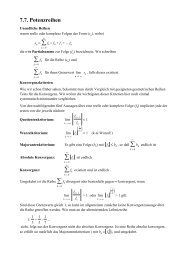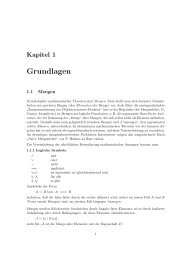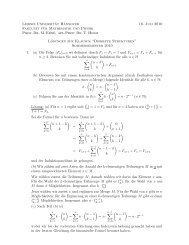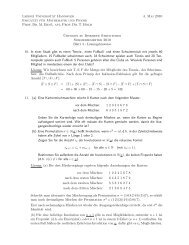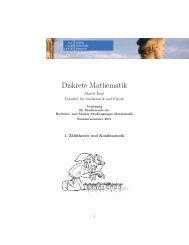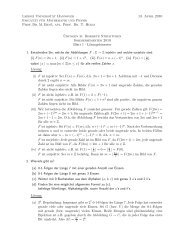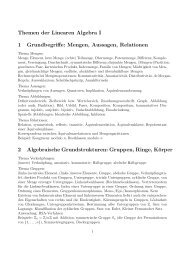MATHEMATICAL LOGIC QUARTERLY - Leibniz Universität Hannover
MATHEMATICAL LOGIC QUARTERLY - Leibniz Universität Hannover
MATHEMATICAL LOGIC QUARTERLY - Leibniz Universität Hannover
Create successful ePaper yourself
Turn your PDF publications into a flip-book with our unique Google optimized e-Paper software.
<strong>MATHEMATICAL</strong><br />
<strong>LOGIC</strong> <strong>QUARTERLY</strong><br />
LQ<br />
A Journal for Mathematical Logic,<br />
Foundations of Mathematics, and Logical Aspects<br />
of Theoretical Computer Science<br />
M<br />
www.mlq-journal.org<br />
Editors<br />
Armin Hemmerling, Greifswald (Managing)<br />
Klaus Ambos-Spies, Heidelberg<br />
Klaus Meer, Cottbus<br />
Marat M. Arslanov, Kazan<br />
Wolfram Pohlers, Münster<br />
Günter Asser, Greifswald<br />
Pavel Pudlak, Prague<br />
John T. Baldwin, Chicago<br />
Andrzej Rosłanowski, Omaha<br />
Douglas S. Bridges, Canterbury<br />
Jörg Rothe, Düsseldorf<br />
Ramon Jansana, Barcelona<br />
Wilfried Sieg, Pittsburgh<br />
Carl G. Jockusch, Urbana<br />
Stephen G. Simpson, State College, PA<br />
Alexander Kechris, Pasadena<br />
Martin Weese, Potsdam<br />
Ulrich Kohlenbach, Darmstadt<br />
Klaus Weihrauch, Hagen<br />
H. Dugald Macpherson, Leeds W. Hugh Woodin, Berkeley<br />
Editorial Assistant:<br />
Heike Oberdörfer, Greifswald<br />
REPRINT
Math. Log. Quart. 55, No. 6, 572 – 586 (2009) / DOI 10.1002/malq.200810034<br />
Finiteness conditions and distributive laws for<br />
Boolean algebras<br />
Marcel Erné ∗<br />
<strong>Leibniz</strong> <strong>Universität</strong> <strong>Hannover</strong>, IAZD, Welfengarten 1, D-30167 <strong>Hannover</strong>, Germany<br />
Received 7 October 2008, revised 24 February 2009, accepted 3 March 2009<br />
Published online 16 November 2009<br />
Key words Atomistic lattice, Boolean algebra, chain condition, compact, continuous lattice, Dedekind finite,<br />
M-prime, M-distributive, pseudocomplemented.<br />
MSC (2000) 06E10, 03E25, 06B35, 06D05<br />
We compare diverse degrees of compactness and finiteness in Boolean algebras with each other and investigate<br />
the influence of weak choice principles. Our arguments rely on a discussion of infinitary distributive laws<br />
and generalized prime elements in Boolean algebras. In ZF set theory without choice, a Boolean algebra is<br />
Dedekind finite if and only if it satisfies the ascending chain condition. The Denumerable Subset Axiom (DS)<br />
implies finiteness of Boolean algebras with compact top, whereas the converse fails in ZF. Moreover, we derive<br />
from DS the atomicity of continuous Boolean algebras. Some of the results extend to more general structures<br />
like pseudocomplemented semilattices.<br />
c○ 2009 WILEY-VCH Verlag GmbH & Co. KGaA, Weinheim<br />
1 Introduction<br />
Since the pioneering work of the Tarski school in the middle of the last century, many mathematical proofs involving<br />
the Axiom of Choice (AC) have been revisited under the viewpoint of effectively weaker choice principles<br />
leading to the same conclusions. Two of these principles proved to be of particular use in quite diverse areas of<br />
mathematics, namely the Ultrafilter Principle<br />
UP<br />
every (proper) filter on a set may be extended to an ultrafilter,<br />
and the Principle of (Countable) Dependent Choices<br />
DC<br />
for any relation ϱ on a nonempty set X such that for each x∈X there is a y with xϱy,<br />
there exists a sequence (x n ) with x n ϱx n+1 for all n.<br />
Whereas Scott [39] and Tarski [41] discovered already in 1954 that the Ultrafilter Principle is equivalent to<br />
several topological compactness theorems and prime ideal theorems, specifically the Prime Ideal Theorem for<br />
Boolean algebras (PIT), it took a while until Halpern [25] was able to show that PIT does not imply the Axiom<br />
of Choice in ZFA (for ZF, see [26]). Later on, Pincus [37] succeeded in showing that even the combination of<br />
UP with DC is not enough to derive AC ; moreover, it is known from Cohen’s forcing method that the axioms UP<br />
and DC are independent of each other (see e.g. Jech [30]). Howard and Rubin [28] showed that PIT plus C ω ,the<br />
Axiom of Choice for countable families, still does not imply DC.<br />
Since Dedekind’s ingenious pioneering work [10] on the foundations of set theory, one knows that Dedekindfiniteness<br />
(which forbids equipollent proper subsets) is equivalent to the exclusion of denumerable subsets.<br />
Hence, the Denumerable Subset Axiom<br />
DS<br />
every infinite set contains a denumerable (= countably infinite) subset<br />
is tantamount to the postulate that every Dedekind-finite set is finite (i.e., equipollent to a natural number);<br />
∗ e-mail: erne@math.uni-hannover.de<br />
c○ 2009 WILEY-VCH Verlag GmbH & Co. KGaA, Weinheim
Math. Log. Quart. 55, No. 6 (2009) / www.mlq-journal.org 573<br />
the converse is valid without assuming any choice principles. DS easily follows from C ω , which in turn is a<br />
consequence of DC. To show that the converse implications fail in ZF set theory and that DS does not follow<br />
from UP is a much more difficult task; Jech [30, pp. 81/97] has pointed out that in a certain model of set theory,<br />
called the basic Cohen model, the Ultrafilter Principle is valid, while the reals possess an infinite subset with no<br />
denumerable subset (see also [29]). For much more material concerning a large variety of choice principles and<br />
their dependence or independence, respectively, see Howard and Rubin [29], Jech [30, 31], the historical survey<br />
by Moore [36], and the fascinating book by Herrlich [27].<br />
The deductive strength of the Ultrafilter Principle was demonstrated impressively by Banaschewski (see<br />
[1] – [4] for a selection of his earlier papers in that area). Of striking elegance is his proof of the equivalence<br />
between PIT and the so-called Prime Element Theorem (PET), providing prime elements in all non-trivial distributive<br />
complete lattices with compact top element (see [2]). A broad spectrum of applications was opened by<br />
the still equivalent but more flexible Separation Lemma for Frames and Quantales, saying that the complement<br />
of any Scott-open filter in a frame or quantale is generated as a downset by prime elements (see Banaschewski<br />
and Erné [5]). In view of the Prime Element Theorem, an obvious question is now: what consequences has the<br />
compactness of the top element for complemented frames, i.e., complete Boolean algebras? It is well-known that<br />
under suitable choice principles like UP or DC, such “compact Boolean frames” must already be finite; here, we<br />
shall see that the Denumerable Subset Axiom suffices for the same conclusion. The key is a careful proof analysis<br />
of the known fact that a distributive lattice satisfying both chain conditions has to be finite – indeed, it turns out<br />
that the same statement with “Dedekind finite” instead of “finite” can be shown in ZF set theory without any<br />
choice principles. From this, one easily deduces that Boolean algebras with compact top element are Dedekind<br />
finite.<br />
A closely related problem is to find seemingly weak conditions that force Boolean frames to be spatial, i.e.,<br />
isomorphic to topologies. Clearly, the spatial Boolean frames are just the atomi(sti)c ones, being isomorphic to<br />
power sets. Here we shall need a few more lattice–theoretical notions. In order to avoid notational confusion and<br />
unnecessary completeness assumptions, we call a lattice L S-continuous [12] if each b ∈ L is the join of ⇓b, the<br />
intersection of all ideals having a join that dominates b , and we say L is compactly generated if each b ∈ L is a<br />
join of compact elements (i.e., elements c with c ≪ c, where a ≪ b means a ∈⇓b). The complete S-continuous<br />
lattices are the continuous lattices in the sense of Scott [24], and the complete compactly generated lattices are<br />
the algebraic ones [8]. By an arithmetic lattice we mean a compactly generated lattice in which the meet of any<br />
two compact elements is compact. It is easy to see, without any choice principles, that S-continuous Boolean<br />
algebras are already arithmetic (cf. [24] for the complete case); indeed, in a Boolean algebra a ≪ b and a ≪ c<br />
imply a≪a ≤ b∧ c (see Section 3). Since UP is equivalent to the spatiality of arithmetic frames (most easily via<br />
the Separation Lemma for Frames [5]), it guarantees that S-continuous complete Boolean algebras are atomistic.<br />
The same result, with no completeness hypothesis, was obtained in [12], using the intermediate result that in<br />
a Boolean algebra with enough prime ideals, ⇓⊤ is the intersection of all non-principal prime ideals, where ⊤<br />
denotes the top (= greatest) element.<br />
On the other hand, Banaschewski and Pultr [6] deduced the atomicity of continuous Boolean algebras from<br />
the fact that an atomless Boolean algebra has properly descending sequences – a consequence of DC, but also,<br />
as our considerations will show, of the weaker axiom DS. We shall demonstrate that DS is equivalent to the<br />
combination of C ω
574 M. Erné: Finiteness conditions and distributive laws for Boolean algebras<br />
2 M-distributivity and M-generation<br />
Let us prepare our investigations on Boolean algebras with a brief but systematic discussion of certain infinite<br />
distributive laws (cf. [18]) and various kinds of irreducible, prime or compact elements in arbitrary posets. The<br />
point is that we have to avoid carefully any choice principles. For any subset B of a poset A, put<br />
↓B = {a ∈ A : a ≤ b for some b ∈ B}, B ↓ = {a ∈ A : a ≤ b for all b ∈ B},<br />
↑B = {a ∈ A : a ≥ b for some b ∈ B}, B ↑ = {a ∈ A : a ≥ b for all b ∈ B}.<br />
While ↓B is the downset and ↑B is the upset generated by B, thesetsB ↓ and B ↑ consist of all lower and<br />
upper bounds of B, respectively. The set B ↑↓ is the cut generated by B. Note that a greatest element ⊤ satisfies<br />
⊤∈ B ↑↓ if and only if ⊤ is the join (supremum) of B, andthata ∈ B ↑↓ means a ≤ ∨ B whenever B has a<br />
join ∨ B. Often it has considerable advantages to work with cuts rather than joins (see e.g. [11, 15] ). As usual,<br />
we write ↓b for the principal ideal ↓{b} = {b} ↓ = {b} ↑↓ and ↑b for the principal filter ↑{b} = {b} ↑ = {b} ↓↑<br />
generated by b ∈ A. GivenasystemM of subsets of A, we put<br />
M ∧ = {↓M : M ∈Mor M = {a} for some a ∈A} ,<br />
a ≪ M b ⇔ a ∈⇓ M b = ⋂ {C ∈M ∧ : b ∈ C ↑↓ } .<br />
The poset A is called M-complete if each M ∈M has a join in A, M-predistributive if each b∈A is the join of<br />
its M-below set ⇓ M b ,andM-distributive if, in addition, A is M-complete. This terminology is justified by the<br />
fact that for a complete lattice, M-distributivity means<br />
∧ ∨ ∨⋂ { B : B ∈X} = X for all X⊆M ∧ .<br />
Each M-distributive lattice satisfies a ∧ ∨ M = ∨ {a ∧ b : b ∈ M} for all M ∈M.Aframe is a complete<br />
lattice A satisfying this equation for each M ⊆ A, andcoframes are defined dually.<br />
An element a of a poset is called M-irreducible if for each M ∈M, a = ∨ M implies a ∈ M, andM-prime<br />
or M-compact if a ≪ M a, i.e. , for each M ∈M, a ∈ M ↑↓ implies a ∈↓M. Clearly, M-prime elements are<br />
M-irreducible, and the converse holds at least for top elements. A poset is said to be M-primely generated<br />
or M-compactly generated or simply M-generated if each of its elements is a join of M-prime elements. All<br />
M-generated posets are M-predistributive. For a more comprehensive discussion of these topics, see Bandelt<br />
and Erné [7, 13, 15, 16, 18].<br />
Let us list some frequently occurring examples of subset systems M and the derived notions of primeness,<br />
irreducibility and distributivity.<br />
M members M-prime M-irreducible<br />
A arbitrary subsets<br />
∨ -prime<br />
∨ -irreducible<br />
B binary subsets ∨-prime or ⊥ ∨-irreducible or ⊥<br />
C chains chain-compact chain-inaccessible<br />
D directed subsets (D-)compact join-inaccessible<br />
E 1-element subsets arbitrary arbitrary<br />
F finite subsets ∨-prime ∨-irreducible<br />
M<br />
M-complete poset<br />
M-generated<br />
complete lattice<br />
M-distributive<br />
complete lattice<br />
A complete lattice superalgebraic lattice supercontinuous lattice<br />
B ∨-semilattice spatial coframe B-distributive complete lattice<br />
C chain-complete poset chain-algebraic lattice chain-continuous lattice<br />
D up-complete (dcpo) algebraic lattice continuous lattice<br />
E arbitrary poset complete lattice complete lattice<br />
F ∨-semilattice with ⊥ spatial coframe dual quasitopology<br />
c○ 2009 WILEY-VCH Verlag GmbH & Co. KGaA, Weinheim<br />
www.mlq-journal.org
Math. Log. Quart. 55, No. 6 (2009) / www.mlq-journal.org 575<br />
A few remarks are in order. If a poset has a least element ∨ ∅ , this is denoted by ⊥ . By a binary subset<br />
we mean a subset with one or two elements, and by a chain a nonempty linearly ordered set. The term “joininaccessible”<br />
[8] is suggestive but conflicts with the notion of inaccessible cardinals.<br />
As in topology, a top element ⊤ of a ∨-semilattice is compact if and only if ⊤ = ∨ B implies ⊤ = ∨ F for<br />
a finite F ⊆ B. In up-complete (but not in arbitrary) posets, compactness and D-compactness coincide, every<br />
compact element is chain-compact, and the reverse implication holds in ZFC, whence the chain-algebraic lattices<br />
are just the algebraic ones; similarly, in ZFC one can prove the equivalence of C- andD-completeness (see<br />
e.g. [16]).<br />
The question as to whether chain-continuous lattices are already continuous has been answered (in the affirmative)<br />
only for cardinality less than ω ω (see Markowsky [35]).<br />
The description of supercontinuous lattices by the complete distributive law involving choice functions (cf. Raney<br />
[38]) requires the full AC . Indeed, Kanai [32] showed that various choice principles are equivalent to certain<br />
“distributive laws” (involving choice functions) for Boolean algebras; corrections and improvements of [32] are<br />
given in [20].<br />
The ∨-primely generated complete lattices are called spatial coframes and their duals spatial frames, because<br />
the latter are just the isomorphic copies of topologies. As shown in [13] and [18], the images of (super-)algebraic<br />
lattices are the (super-)continuous lattices, and the images of topologies under complete homomorphisms are<br />
the dually F-distributive complete lattices, whence these have also been baptized quasitopologies (cf. [34]).<br />
Induction shows that every B-distributive poset is A n -distributive for all n ≤ ω, where A n is the collection<br />
of all subsets with less than n elements; but it seems to be unknown whether B-distributivity is equivalent to<br />
F-distributivity in general. We shall see that this is the case at least for all Boolean algebras.<br />
Given a poset A and a collection M of subsets, let M ∨ denote the set of all members of M that possess<br />
a join. In the absence of M-completeness, the notions of M-predistributivity and of M-primeness have to be<br />
distinguished carefully from M ∨ -predistributivity and M ∨ -primeness, respectively. For example, ω × ω ,the<br />
square of the chain of natural numbers, is a conditionally complete, M ∨ -generated and M ∨ -distributive lattice<br />
for all M (because M ∨ is contained in F and all elements of the form (0,n) or (n, 0) with n ≠0are F-prime),<br />
but ω × ω is not M-predistributive if M contains, say, some set of the form {(x, y) :x ≤ n, y ∈ ω} .Inthis<br />
example we have<br />
⇓b = ⇓ D∨ b = ↓b but ⇓ D b = {(0, 0)} for all b ∈ ω × ω,<br />
whence each element is (D ∨ -)compact, but no element except (0, 0) is D-compact.<br />
Notice that neither of the implication arrows in the hierarchy<br />
M-prime ⇒ M ∨ -prime ⇒ M-irreducible<br />
may be reversed in general, but for top elements all three properties coincide. Fortunately, most of these discrepancies<br />
vanish when we are dealing with Boolean algebras, as we shall see in the next section.<br />
A further concept will be helpful: we say a poset A with least element ⊥ is M-founded (respectively,<br />
M-primely founded ) if for each b∈A with ⊥< b,thereisana with ⊥< a≪ M b (respectively, ⊥
576 M. Erné: Finiteness conditions and distributive laws for Boolean algebras<br />
3 Atoms and distributive laws in Boolean algebras<br />
An atom of a lattice or poset with least element ⊥ is minimal among all elements distinct from ⊥ . None of the<br />
implications<br />
∨ -prime ⇒ ∨-prime<br />
⇓<br />
⇓<br />
atom ⇒ ∨ -irreducible ⇒ ∨-irreducible<br />
may be inverted in general, but in Boolean algebras, all five properties are easily seen to be equivalent.<br />
Throughout this section, A denotes a Boolean algebra, ⊤ its top element, ⊥ its bottom element, and a ∗ the<br />
complement of a ∈A . Observe that for arbitrary elements a, b and subsets C of A,<br />
b ∈ C ↑↓ ⇒ a ∧ b = ∨ {a ∧ b ∧ c : c ∈ C} .<br />
For the proof, note that a ∧ b ∧ c ≤ d implies c ≤ d ∨ (a ∧ b) ∗ for all c ∈ C ,andifb ∈ C ↑↓ ,thenb ≤ d ∨ (a ∧ b) ∗<br />
and so a ∧ b ≤ d. In particular,<br />
b = ∨ C ⇒ a ∧ b = ∨ {a ∧ c : c ∈ C} ,<br />
b ∈ C ↑↓ ⇒ b = ∨ {b ∧ c : c ∈ C} .<br />
Henceforth, we suppose that M is a shiftable system of subsets of A. That is, we postulate that for each a ∈ A<br />
and M ∈M,thesets<br />
↓{a ∧ b : b ∈ M} and ↓{a ∨ b : b ∈ M}<br />
are members of M ∧ . Each system M such that f[M] ∈Mfor all M ∈Mand all isotone self-maps f : A −→ A<br />
is shiftable; in particular, this holds for each of the systems A,...,F listed in Section 2. Furthermore, if M is<br />
shiftable, then so is M ∨ , the system of all sets in M that have a join.<br />
Proposition 3.1 For a ∈ A \{⊥}, the following conditions are equivalent:<br />
(a) a is M-prime;<br />
(b) a is M-irreducible;<br />
(c) a ≪ M ⊤;<br />
(d) a ≪ M b for some b ∈ A.<br />
If B ∧ ⊆M ∧ , then the previous conditions characterize the atoms of A.<br />
Proof. (a)⇒ (b) and (c) ⇔ (d) hold in arbitrary posets with top.<br />
(b) ⇒ (c). If ⊤ = ∨ M for an M ∈M,thenwehavea = a ∧⊤ = ∨ N for N = ↓{a ∧ b : b ∈ M} ∈M ∧ ,<br />
hence a = a ∧ b ≤ b for some b ∈ M.<br />
(c) ⇒ (a). If a ∈ M ↑↓ for an M ∈M,thenM ≠ ∅ (as a ≠ ⊥), and we obtain ⊤ = ∨ N for the set<br />
N = ↓{a ∗ ∨ b : b ∈ M} ∈M ∧ (indeed, N ⊆↓c implies a ∗ ∨ b ≤ c for all b ∈ M, hence a ∨ c = ⊤ and<br />
M ⊆↓c ;now,a ∈ M ↑↓ entails a ≤ c = ⊤). Thus, a≪ M ⊤ yields a ≤ a ∗ ∨ b and a ≤ b for a b ∈ M. Note that<br />
⊥ is not M-irreducible if ∅∈M ∧ , although ⊥≪ M ⊤ if ⊥ ≠ ⊤.<br />
Clearly, atoms are M-irreducible. On the other hand, if a is not an atom, say ⊥< b
Math. Log. Quart. 55, No. 6 (2009) / www.mlq-journal.org 577<br />
Proposition 3.3 The following statements are equivalent:<br />
(a) A is M-generated;<br />
(b) A is M-predistributive;<br />
(c) A is M-(primely) founded;<br />
(d) ⊤ isajoinofM-prime (resp. M-irreducible) elements;<br />
(e) ⊤ = ∨ ⇓ M ⊤.<br />
In each of these statements, M may be replaced with M ∨ .<br />
P r o o f. The implications (a) ⇒ (b) ⇒ (c) and (a) ⇒ (d) ⇒ (e) are clear.<br />
(c) ⇒ (e). Assume ⇓ M ⊤⊆↓b but b ≠ ⊤. Then⊥
578 M. Erné: Finiteness conditions and distributive laws for Boolean algebras<br />
4 Chain conditions and finiteness<br />
Remember that in posets, the ascending chain condition (acc) excludes properly ascending sequences, and the<br />
descending chain condition (dcc) has the dual meaning. The next proposition is known in ZF with choice, but<br />
one has to be very careful if one intends to avoid rigorously any choice principles.<br />
Proposition 4.1 A distributive lattice is Dedekind finite if and only if it satisfies both chain conditions (the acc<br />
and the dcc).<br />
P r o o f. Clearly, a Dedekind-finite lattice must satisfy both chain conditions. Suppose now that L is a<br />
Dedekind-infinite distributive lattice and choose an infinite sequence (a n ) of distinct elements in L. For each<br />
n ∈ ω, the sublattice L n generated by A n = {a k : k < n} is finite, and the sublattice L ω generated by<br />
A ω = {a k : k
Math. Log. Quart. 55, No. 6 (2009) / www.mlq-journal.org 579<br />
Theorem 4.4 The Denumerable Subset Axiom is equivalent to each of the following four statements combined<br />
with C ω
580 M. Erné: Finiteness conditions and distributive laws for Boolean algebras<br />
P r o o f. The implications (a) ⇒ (b) ⇒ (c) are clear.<br />
(c) ⇒ (a). As in the proof of Theorem 4.4 we conclude from (c) that the MacNeille completion N A is a<br />
complete Boolean algebra with compact top element, so that by Corollary 3.2, applied to M = D, every directed<br />
subset of N A and so every directed subset of A has a greatest element.<br />
(a) ⇒ (d). D = { ∨ F : F ⊆ B, F finite} is a directed subset of A; its greatest element is the least upper<br />
bound of B.<br />
(d) ⇒ (a). If D is directed and F ⊆ D is finite with ∨ F = ∨ D, then any upper bound of F in D must be the<br />
greatest element of D.<br />
(a) ⇒ (e). If A is Noetherian, then it satisfies the acc, and by Corollary 4.2, it is Dedekind finite; moreover, all<br />
elements are compact.<br />
(e) ⇒ (c). ⊤ is ω-chain-compact by the acc and so compact by (e).<br />
Clearly, (f) implies (a), and if DS is valid, (e) implies (f).<br />
Theorem 4.8 The following statements are mutually equivalent in ZF and are derivable from either of the<br />
axioms DS and UP, but not conversely:<br />
(a) Boolean algebras with compact top are finite;<br />
(b) nontrivial Boolean algebras with compact top have an atom;<br />
(c) compact elements of Boolean algebras are finite joins of atoms;<br />
(d) compactly generated Boolean algebras are atomic;<br />
(e) S-continuous (resp. D-predistributive) Boolean algebras are atomic;<br />
(f) Boolean algebras whose top is a join of compact elements are atomic;<br />
(g) Boolean algebras whose top is the join of its way-below ideal are atomic.<br />
P r o o f. The implications (a) ⇒ (b) and (c) ⇒ (d) are obvious.<br />
(b) ⇒ (c). If c is a compact element of a Boolean algebra, then each non-minimal element of the Boolean<br />
algebra ↓ c is compact, too, so it contains an atom, provided (b) holds. Hence, ↓ c is atom(ist)ic and c is a finite<br />
join of atoms.<br />
(d) ⇒ (a). If the top element ⊤ and consequently each element of a Boolean algebra A is compact, then<br />
from (d) it follows that ⊤ is a join of atoms, a finite number of which suffice by compactness. Thus, A is a finite<br />
power set algebra.<br />
The statements (d) – (g) are equivalent by Corollary 3.4.<br />
By Theorem 4.4, in ZF + DS any Boolean algebra with compact top is finite. Alternatively, that conclusion<br />
may also be drawn from the Prime Ideal Theorem (which does not imply DS, see below): as shown in [12], the<br />
way-below ideal ⇓⊤ consists exactly of all finite joins of atoms if it is the intersection of prime ideals.<br />
It is now easy to confirm the claim that finiteness of compact Boolean algebras (which follows from UP)<br />
together with C ω
Math. Log. Quart. 55, No. 6 (2009) / www.mlq-journal.org 581<br />
Corollary 4.11 For a Boolean algebra A and its top element ⊤, the following implications and equivalences<br />
hold in ZF:<br />
⊤is a finite join of atoms ⇔ A is finite<br />
⇓<br />
⊤is compact ⇔ A is Noetherian<br />
⇓<br />
⊤is chain-compact<br />
and A is chain-complete<br />
⇔ A has no chain without greatest element<br />
⇓<br />
⊤is ω-chain-compact<br />
and A is ω C-complete<br />
⇔ A satisfies the acc ⇔ A is Dedekind finite<br />
A<br />
If A is complete, one has the following implications and equivalences:<br />
A is superalgebraic ⇔ A is supercontinuous ⇔ A is atomic<br />
⇓<br />
A is algebraic ⇔ A is continuous ⇔ ⊤ = ∨ ⇓⊤<br />
⇓<br />
A is chain-algebraic ⇔ A is chain-continuous ⇔ ⊤ = ∨ ⇓ C ⊤<br />
⇓<br />
A is ω C-generated ⇔ A is ω C-distributive ⇔ ⊤ = ∨ ⇓ ω C ⊤<br />
B<br />
In ZF + UP, thefirst four statements in Diagram A are equivalent, and so are the first six statements about<br />
complete Boolean algebras in Diagram B.<br />
In ZF + DS, all statements in Diagram A are equivalent, and so are all statements about complete Boolean<br />
algebras in Diagram B.<br />
The lattice of all countable or cofinite subsets of the first uncountable ordinal ω 1 is distributive (being closed<br />
under finite unions and intersections). Note that its top element ω 1 is ω-chain-compact but not chain-compact,<br />
being the union of the well-ordered chain of all smaller ordinals.<br />
In the atomic case, the situation becomes much more transparent:<br />
Theorem 4.12 For an atomic Boolean algebra A, the following conditions are equivalent in ZF:<br />
(a) A is finite; (a’) PA is finite; (a”) PA is Dedekind finite;<br />
(b) A is Noetherian; (b’) PA is Noetherian; (b”) PA satisfies the acc.<br />
P r o o f. The implications (a) ⇒ (b) and (a) ⇒ (a’) ⇒ (b’) ⇒ (b”) are clear, and the equivalence (a”) ⇔ (b”) has<br />
been established in Corollary 4.2.<br />
(b) ⇒ (a). Being directed, the set J of all finite joins of atoms has a greatest element b. Ifb ≠ ⊤, there would<br />
be an atom a ≰ b, whence b
582 M. Erné: Finiteness conditions and distributive laws for Boolean algebras<br />
Sometimes, Noetherian posets are defined by the condition that every nonempty subset has a maximal element;<br />
let us speak of strongly maximized posets in that case. Of course, every strongly maximized poset is Noetherian,<br />
but the converse is dubious in ZF without choice. However, in ZF + DC, one has the equivalences<br />
P is strongly maximized ⇔ P is Noetherian ⇔ P satisfies the acc.<br />
While we do not know whether all compact ( = Noetherian) Boolean algebras have to be finite in ZF, this is<br />
certainly the case for all strongly maximized Boolean algebras: any such Boolean algebra must be (co-)atomic<br />
and compact, whence the top element is a join of finitely many atoms.<br />
5 Booleanization and continuity<br />
In order to extend some of the previous results to more general structures than Boolean algebras, we need a few<br />
weaker complementation concepts. A bounded poset S is ∨-pseudocomplemented if for each a ∈ S there is a<br />
least a ∗ (called the ∨-pseudocomplement of a) with a ∨ a ∗ = ⊤, while S is ∨-semicomplemented if for each<br />
a>⊥ there is some c
Math. Log. Quart. 55, No. 6 (2009) / www.mlq-journal.org 583<br />
Theorem 5.4 Let M be a system of subsets of a complete lattice A with B ∧ ⊆M ∧ .ThenA is ∨-semicomplemented<br />
and M-predistributive if and only if it is an atomic Boolean algebra, hence isomorphic to a power<br />
set.<br />
Proof. A B-distributive complete lattice is a coframe, hence a power set algebra if ∨-semicomplemented.<br />
Conversely, an atomistic Boolean algebra is ∨-semicomplemented and M-predistributive (in fact M-generated),<br />
because the atoms are join-dense and M-prime.<br />
The dual of Theorem 5.4 yields a strong spatiality criterion for quasitopologies (cf. [34] for a related result):<br />
Corollary 5.5 A ∧-semicomplemented quasitopology is already discrete, i.e. isomorphic to a power set.<br />
The completeness assumption is essential in Theorem 5.4. Consider once more the lattice L of all countable or<br />
cofinite subsets of ω 1 , which is distributive but neither complete nor complemented, hence not a Boolean algebra.<br />
However, this lattice is atomistic: the atoms are the singletons, and any such atom a is A-prime, as L \↑a = ↓a ∗<br />
with a ∗ = ω 1 \ a. Hence, the lattice L is M-(primely) generated and, in particular, M-predistributive for any M.<br />
Moreover, L is ∨-semicomplemented (being coatomistic) but not ∨-pseudocomplemented. Nevertheless, “complete”<br />
may be replaced by “complemented” in Theorem 5.4.<br />
By the (dualized) Glivenko–Frink Theorem [23], the (∨-)skeleton or (∨-) Booleanization of any (∨-)pseudocomplemented<br />
(∨-)semilattice S,<br />
S ∗ = {a ∗ : a ∈ S} = {a ∈ S : a = a ∗∗ }<br />
is a Boolean algebra, with binary meet a ∧ b =(a ∗ ∨ b ∗ ) ∗ and complement a ∗ for a in S ∗ . Moreover, S ∗ is<br />
join-closed in S. Note also that<br />
(M ↑ ∩ S ∗ ) ↓ = M ↑↓ for all M ⊆ S ∗ .<br />
Indeed, if M ⊆ S ∗ , b ∈ (M ↑ ∩ S ∗ ) ↓ and c ∈ M ↑ ,thenc ∗∗ ∈ M ↑ ∩ S ∗ and therefore b ≤ c ∗∗ ≤ c ; thus b ∈ M ↑↓ .<br />
Proposition 5.6 Let S be a ∨-pseudocomplemented ∨-semilattice, M a system of subsets such that for all<br />
a ∈ S, M ∈Mholds ↓{a ∨ b : b ∈ M} ∈M ∧ , and put M X = {M ∈M: ∅ ≠ M ⊆ X} for X ⊆ S. Then:<br />
(0) a ≪ M b in S implies a ∗∗ ≪ MS∗ b ∗∗ in S ∗ .<br />
(1) If c ≪ M ⊤,thenA = {a ∈ S ∗ : a ≤ c} is a Boolean algebra in which every element is M A -prime; hence,<br />
each member of M A has a greatest element if A is M A -complete (in particular, if S is M-complete).<br />
(2) If S is ∨-complemented and M-founded, then S ∗ is an M S∗ -generated and hence M S∗ -predistributive<br />
Boolean algebra.<br />
P r o o f. (0) Given M ∈M S∗ and b ∈ S with b ∗∗ ∈ (M ↑ ∩ S ∗ ) ↓ = M ↑↓ ,weget⊤ = ∨ {b ∗ ∨ d : d ∈ M},<br />
because b ∗ ∨d ≤ c for all d ∈ M ≠ ∅ implies c ∈ M ↑ , hence b ∗∗ ≤ c and c = b ∗ ∨c =⊤. Now,ifa ≪ M b ,there<br />
is a d ∈ M with a ≤ b ∗ ∨d . Furthermore, a ≤ b entails b ∗ ≤ a ∗ , and we obtain ⊤= a ∗ ∨a ≤ a ∗ ∨ b ∗ ∨d = a ∗ ∨d ,<br />
hence a ∗∗ ≤ d , as required for a ∗∗ ≪ MS∗ b ∗∗ .<br />
(1) Since S ∗ is a Boolean algebra, the principal ideal A in S ∗ with top c ∗∗ is Boolean, too. As we saw in (0),<br />
c ≪ M ⊤ in S implies c ∗∗ ≪ MS∗ ⊤ in S ∗ , and by Corollary 3.2, it follows that all elements of A are M A -prime.<br />
(2) Assume ⊥< b= b ∗∗ in S ∗ and choose a ∈ S with ⊥< a≪ M b.By∨-complementation, we have a ∗
584 M. Erné: Finiteness conditions and distributive laws for Boolean algebras<br />
Regarding Parts (2) in Proposition 5.6 and Theorem 5.7, one might wonder if the hypothesis of ∨-complementation<br />
may be weakened to ∨-pseudocomplementation. The subsequent remarks will destroy that hope.<br />
Necessary and sufficient conditions for atomicity and for finiteness, respectively, of the skeleton of a ∨-pseudocomplemented<br />
semilattice or poset S have been established in [19], using the notion of upper antichains, i.e.,<br />
subsets no two elements of which have a common upper bound in the whole poset S, and of spoonful posets, i.e.,<br />
posets having a cofinal subset of elements that generate directed principal filters:<br />
Theorem 5.9 A ∨-pseudocomplemented semilattice S has a finite skeleton if and only if S ′ = S \{⊤}has<br />
acofinal subset containing no infinite upper antichain. Similarly, S has an atomic skeleton if and only if S ′ is<br />
spoonful. In ZF + DC, this is equivalent to the exclusion of binary trees no two elements of which have a common<br />
upper bound in S ′ .<br />
A straightforward verification shows that a cofinal subposet Q of a poset P is spoonful if and only if the entire<br />
poset P is spoonful. Applying this to P = A ∧ S ′ \{S ′ }, where A ∧ S ′ = {↓B : B ⊆ S ′ } is the downset lattice<br />
of S ′ = S \{⊤}, and observing that S ′ is isomorphic to the cofinal subset {S ′ \↑a : a ∈ S ′ } of P , we conclude:<br />
Corollary 5.10 The skeleton S ∗ is atomic if and only if the skeleton of A ∧ S ′ is atomic.<br />
In that way, one may associate with any ∨-pseudocomplemented semilattice S whose skeleton is not atomic<br />
(e.g. with any atomless Boolean algebra) a superalgebraic one, A ∧ S ′ , whose skeleton is not atomic either. This<br />
produces a plethora of A-generated (hence ∨-pseudocomplemented, A-distributive and weakly atomic) complete<br />
lattices having a non-atomic skeleton.<br />
6 Topological compactness for Boolean algebras<br />
In this final section, we compare the lattice-theoretical notion of compactness for (the top of) a Boolean algebra<br />
with compactness in certain intrinsic topologies. Frink [22] introduced ideals in posets as (not necessarily<br />
directed)<br />
⋂<br />
subsets I such that F ↑↓ ⊆ I for each finite<br />
⋂<br />
F ⊆ I and defined the ideal topology by taking the<br />
-irreducible ideals together with the dually defined -irreducible filters as a subbase for the open sets. This<br />
topology may be very weak in the absence of choice principles. Therefore, we define the closed ideal topology<br />
on a poset to be the coarsest topology making all ideals and all filters closed; assuming the Axiom of Choice, one<br />
concludes that the ⋂ -irreducible ideals and filters form a subbase for the closed sets. In a Boolean algebra, each<br />
of the following notions amounts to the same concept:<br />
- maximal (proper) ideal,<br />
- complement of an ultrafilter,<br />
- ⋂ -irreducible ideal,<br />
- complement of a ⋂ -irreducible filter,<br />
- prime ideal,<br />
- complement of a prime filter.<br />
Hence, the ideal topology is the coarsest topology making all prime ideals both open and closed. Thus, the Prime<br />
Ideal Theorem ensures that the ideal topology and the closed ideal topology coincide on Boolean algebras. In<br />
contrast to that coincidence, the ideal topology on [0, 1] n is the (compact) Euclidean topology, whereas the closed<br />
ideal topology is discrete.<br />
Proposition 6.1 A poset that is compact in the closed ideal topology is Noetherian. In particular, a Boolean<br />
algebra that is compact in the closed ideal topology must be Dedekind finite and complete.<br />
Proof. IfD is a directed subset of a poset with compact closed ideal topology, then {↑ d : d ∈ D}∪{↓D}<br />
is a system of closed sets finitely many of which always intersect. Thus, the system has a nonempty intersection,<br />
i.e., D has a greatest member.<br />
c○ 2009 WILEY-VCH Verlag GmbH & Co. KGaA, Weinheim<br />
www.mlq-journal.org
Math. Log. Quart. 55, No. 6 (2009) / www.mlq-journal.org 585<br />
Corollary 6.2 In ZF+UP, the following statements on a Boolean algebra A are equivalent:<br />
(a) A is compact in the (closed) ideal topology;<br />
(b) A is finite;<br />
(c) A is Noetherian;<br />
(d) the top element (and so each element) of A is compact.<br />
Compare this with a known result about the interval topology, the coarsest topology in which all principal<br />
ideals and principal filters are closed [17]:<br />
Proposition 6.3 The Ultrafilter Principle holds if and only if every complete (Boolean) lattice is compact in<br />
the interval topology.<br />
Corollary 6.4 For a lattice L, the following are equivalent in ZF + UP:<br />
(a) L and its dual are Noetherian;<br />
(b) the closed ideal topology on L is compact;<br />
(c) L is complete and the closed ideal topology coincides with the interval topology.<br />
For various topological conditions equivalent to the atomicity of Boolean algebras, we refer to [12].<br />
References<br />
[1] B. Banaschewski, The power of the ultrafilter theorem. J. London Math. Soc. 27, 193–202 (1983).<br />
[2] B. Banaschewski, Prime elements from prime ideals. Order 2, 211–213 (1985).<br />
[3] B. Banaschewski, The prime ideal theorem and representation of F-rings. Algebra Universalis 25, 384–387 (1988).<br />
[4] B. Banaschewski and R. Harting, Lattice aspects of radical ideals and choice principles. Proc. London Math. Soc. 50,<br />
385–404 (1985).<br />
[5] B. Banaschewski and M. Erné, On Krull’s separation lemma. Order 10, 253–260 (1993).<br />
[6] B. Banaschewski and A. Pultr, Booleanization. Cahiers de Top. et Geom. Diff. Cat. 37, 41–60 (1996).<br />
[7] H.–J. Bandelt and M. Erné, Representations and embeddings of M-distributive lattices. Houston J. Math. 10, 315–324<br />
(1984).<br />
[8] G. Birkhoff, Lattice Theory (Amer. Math. Soc. Coll. Publ. 25, 3rd ed., 1973).<br />
[9] P. Crawley and R. P. Dilworth, Algebraic Theory of Lattices (Prentice-Hall, 1973).<br />
[10] R. Dedekind, Was sind und was sollen die Zahlen? (Vieweg, 1 st ed. 1887, 10 th ed. 1969).<br />
[11] M. Erné, Verallgemeinerungen der Verbandstheorie I–II. (Tech. Report No. 109, Habilitationsschrift, University of<br />
<strong>Hannover</strong>, 1979–1980).<br />
[12] M. Erné, Order-topological lattices. Glasgow Math. J. 21, 57–68 (1980).<br />
[13] M. Erné, Homomorphisms of M-distributive and M-generated posets. (Tech. Report No. 125, University of <strong>Hannover</strong>,<br />
1981).<br />
[14] M. Erné, On the existence of decompositions in lattices. Algebra Universalis 16, 338–343 (1983).<br />
[15] M. Erné, The Dedekind-MacNeille completion as a reflector. Order 8, 159–173 (1991).<br />
[16] M. Erné, Algebraic ordered sets and their generalizations. In: Algebras and Orders, Proc. Montreal 1992 (I. Rosenberg<br />
and G. Sabidussi, eds.) (Kluwer, 1994).<br />
[17] M. Erné, Prime ideal theorems and systems of finite character. Comment. Math. Univ. Carolinae 38, 513–536 (1997).<br />
[18] M. Erné, Z-continuous posets and their topological manifestation. Appl. Cat. Structures 7, 31–70 (1999).<br />
[19] M. Erné, Prime decomposition and pseudocomplementation. In: Contributions to General Algebra 17, Proceedings<br />
Vienna Conference 2005 (G. Eigenthaler et al., eds.) (Heyn, 2006).<br />
[20] M. Erné, Choice principles and distributive laws for Boolean algebras. (Preprint, University of <strong>Hannover</strong>, 2006).<br />
[21] R. Fraïssé, Theory of Relations. Studies in Logic 118 (North-Holland, 1986).<br />
[22] O. Frink, Ideals in partially ordered sets. Amer. Math. Monthly 61, 223–234 (1954).<br />
[23] O. Frink, Pseudo-complements in semi-lattices. Duke Math. J. 29, 505–514 (1962).<br />
[24] G. Gierz, K. H. Hofmann, K. Keimel, J. D. Lawson, M. Mislove, and D. S. Scott, A Compendium of Continuous Lattices<br />
(Springer, 1980).<br />
[25] Halpern, J., The independence of the Boolean prime ideal theorem from the axiom of choice. Fund. Math. 55, 57–66<br />
(1964).<br />
[26] J. Halpern and A. Levy, The Boolean prime ideal theorem does not imply the axiom of choice. In: Axiomatic Set Theory,<br />
Proc. Symp. Pure Math., Univ. of California, L.A., 13 (D.S. Scott, ed.), pp. 83–124 (1967).<br />
[27] H. Herrlich, Axiom of Choice. Lecture Notes in Mathematics. (Springer, 2006).<br />
[28] P. Howard and J. E. Rubin, The Boolean prime ideal theorem plus countable choice do not imply dependent choice.<br />
Math. Logic Quart. 42, 410–420 (1996).<br />
www.mlq-journal.org<br />
c○ 2009 WILEY-VCH Verlag GmbH & Co. KGaA, Weinheim
586 M. Erné: Finiteness conditions and distributive laws for Boolean algebras<br />
[29] P. Howard and J. E. Rubin, Consequences of the Axiom of Choice. Math. Surveys and Monographs 59, Amer. Math.<br />
Soc. (Providence, 1998).<br />
[30] T. J. Jech, The Axiom of Choice (North-Holland Publ. Co. 1973).<br />
[31] T. Jech, Set Theory. (Springer 2003).<br />
[32] Y. Kanai, On the deductive strength of various distributivity axioms for Boolean algebras in set theory. Math. Logic<br />
Quart. 48, 413–426 (2002).<br />
[33] S. Koppelberg, Handbook of Boolean Algebras, Volume 1 (D. Monk and R. Bonnet, eds.) (North-Holland, 1989).<br />
[34] I. Kříž and A. Pultr, A spatiality criterion and a quasitopology which is not a topology. Houston J. Math. 15, 215–233<br />
(1989).<br />
[35] G. Markowsky, Propaedeutic to chain-complete posets with basis. In: Continuous Lattices, Lecture Notes in Math. 871,<br />
(Springer 1981).<br />
[36] G. H. Moore, Zermelo’s Axiom of Choice. (Springer 1982).<br />
[37] D. Pincus, Adding dependent choice to the prime ideal theorem. Logic Colloquium 76, Studies in Logic and the Foundations<br />
of Mathematics 96 (North-Holland, 1977).<br />
[38] G. N. Raney, A subdirect-union representation for completely distributive complete lattices. Proc. Amer. Math. Soc. 4,<br />
518–522 (1953).<br />
[39] D. S. Scott, Prime ideal theorems for rings, lattices and Boolean algebras (Abstract). Bull. Amer. Math. Soc. 60, 390<br />
(1954).<br />
[40] A. Tarski, Sur les classes closes par rapport á certaines opérations élémentaires. Fund. Math. 16, 181–305 (1929).<br />
[41] A. Tarski, Prime ideal theorems for Boolean algebras and the axiom of choice (Abstract). Bull. AMS 60, 390–391<br />
(1954).<br />
c○ 2009 WILEY-VCH Verlag GmbH & Co. KGaA, Weinheim<br />
www.mlq-journal.org


